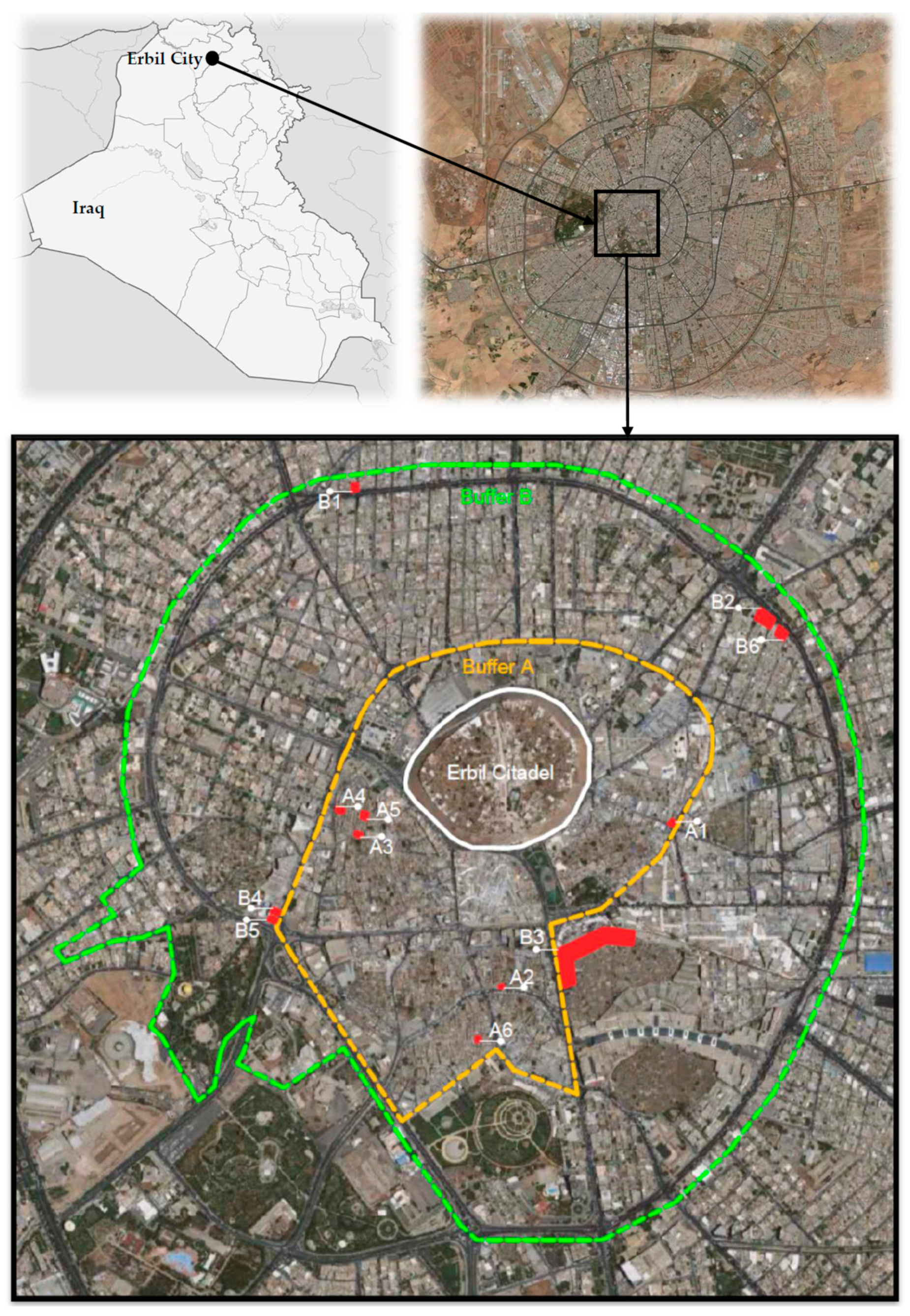Erbil City Built Heritage and Wellbeing: An Assessment of Local Perceptions Using the Semantic Differential Scale
Abstract
1. Introduction
2. Perceiving Built Heritage and Wellbeing
3. Measuring Perception
3.1. Hypothesis Development
3.2. Case Study
3.3. Participants and Procedure
4. Discussion
4.1. High-Quality Heritage Buildings
4.2. Contrasting Buildings
4.3. Comparing Perceptions
5. Conclusions and Recommendations
Author Contributions
Funding
Informed Consent Statement
Data Availability Statement
Acknowledgments
Conflicts of Interest
Appendix A



Appendix B
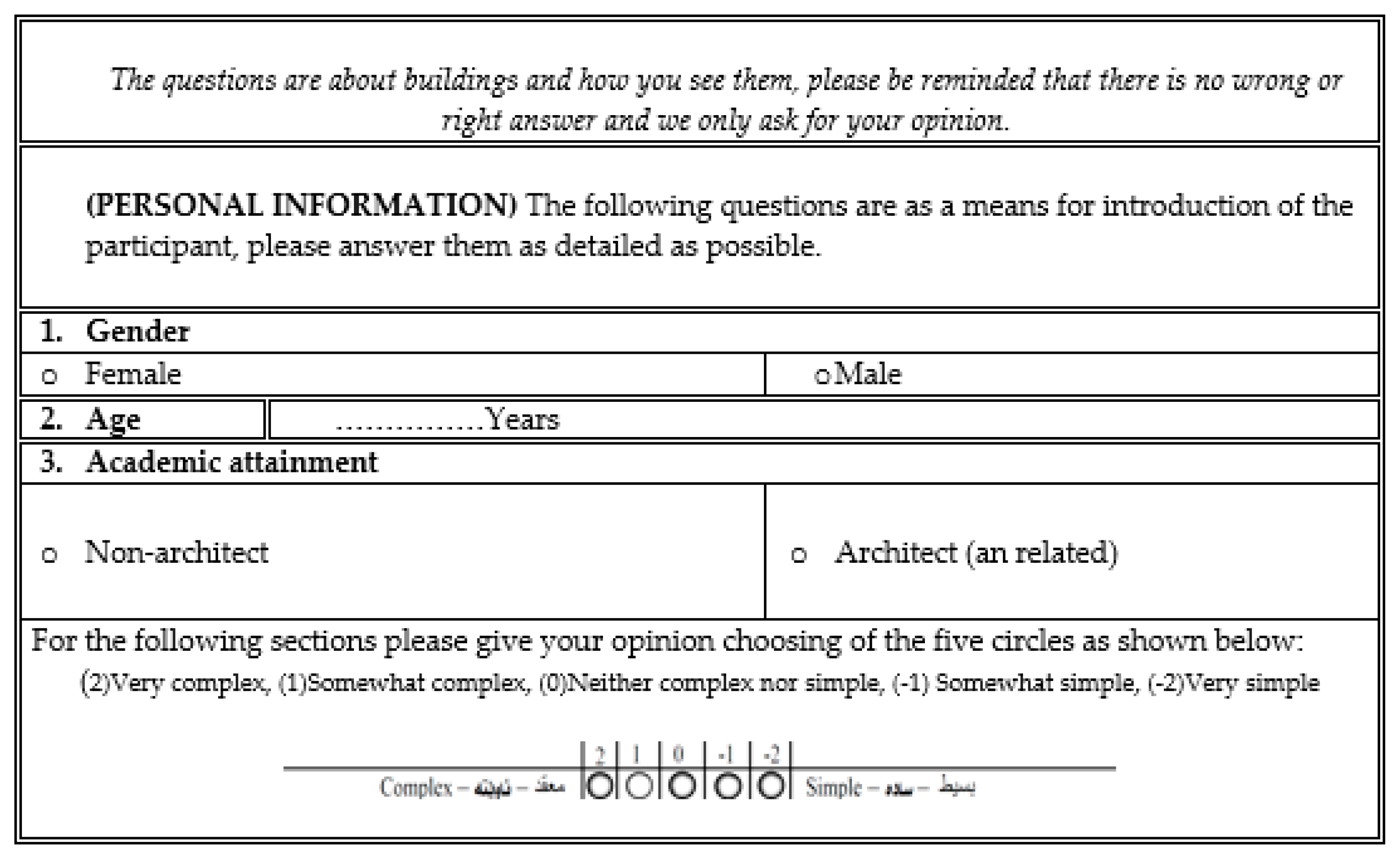
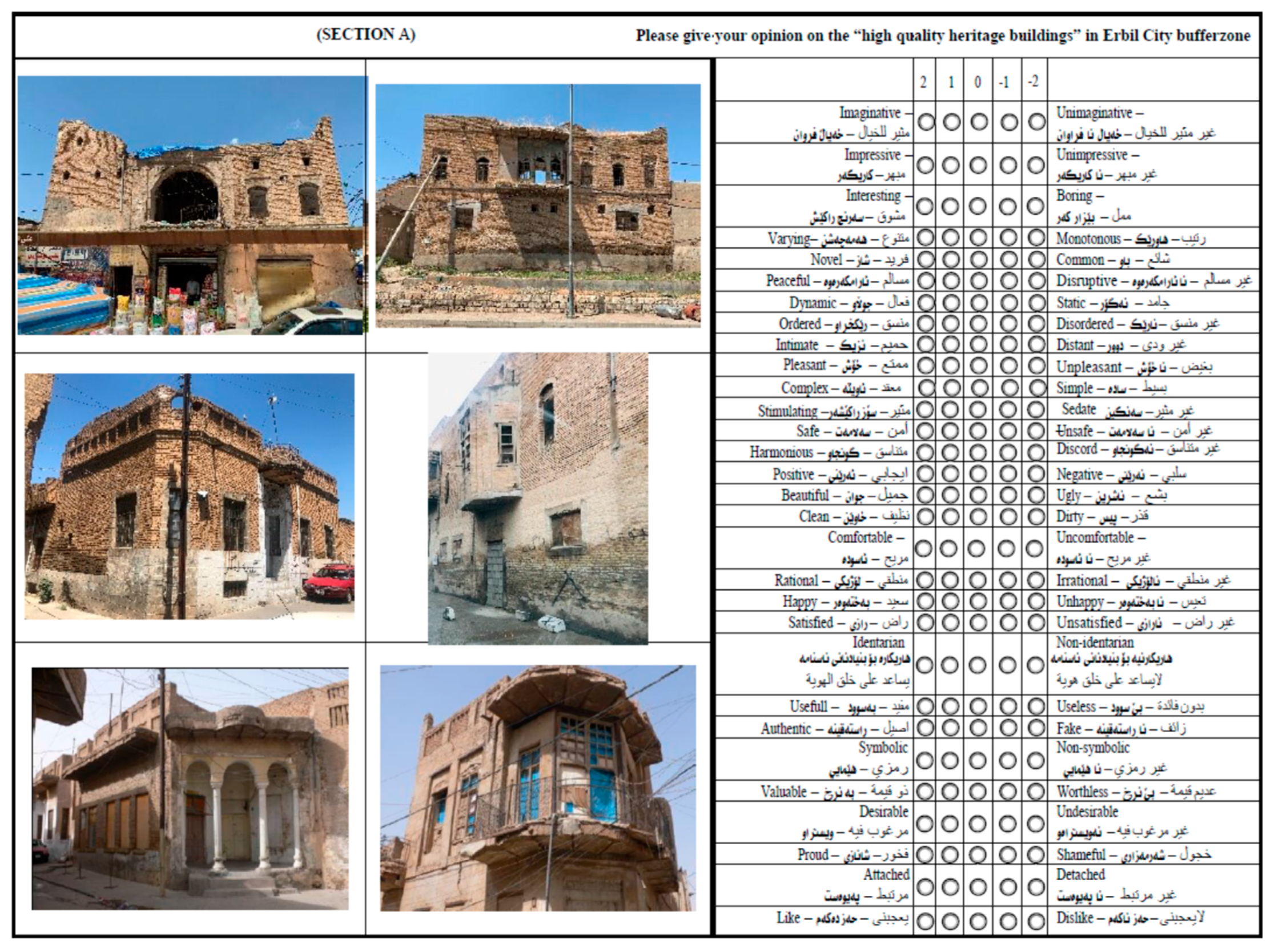
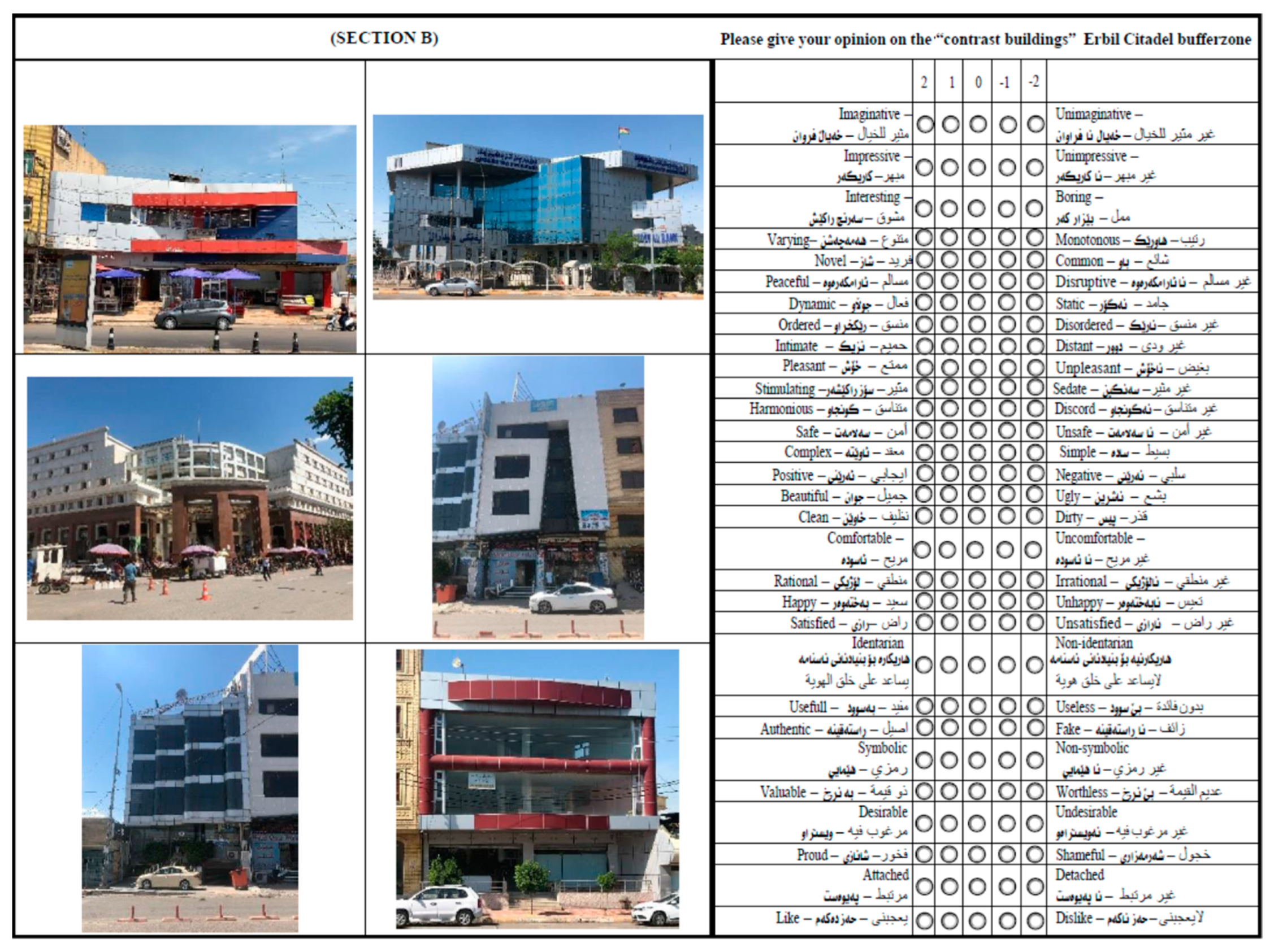
References
- Pirkovic, J. Understanding the Convention into Challenging actions for Member States. In Heritage and Beyond; Council of Europe Publishing: Strasbourg Cedex, France, 2009; pp. 23–27. [Google Scholar]
- Fairclough, G. New Heritage Frontiers. In Heritage and Beyond; Council of Europe Publishing: Strasbourg, France, 2009; pp. 29–41. [Google Scholar]
- Vinas, S.M. Contemporary theory of conservation. Stud. Conserv. 2002, 47, 25–34. [Google Scholar] [CrossRef]
- Clark, K. The shift toward values in UK heritage practice. In Values in Heritage Management: Emerging Approaches and Research Directions; Avrami, E., Macdonald, S., Mason, R., Myers, D., Eds.; Getty Trust: Los Angeles, CA, USA, 2019; pp. 66–82. [Google Scholar]
- Serageldin, M. Preserving the historic urban fabric in a context of Fast-paced change. In Historic Cities: Issues in Urban Conservation; Cody, J., Siravo, F., Eds.; Getty Conservation Institute: Los Angeles, CA, USA, 2019; Volume 8, pp. 175–184. [Google Scholar]
- Matero, F. Preface. In Managing Change: Sustainable Approaches to the Conservation of the Built Environment 4th Annual US/ICOMOS International Symposium Organized by US/ICOMOS, the Graduate Program in Historic Preservation of the University of Pennsylvania, and the Getty Conse; Teutonico, J.M., Matero, F., Eds.; J. Paul Getty Trust: Philadelphia, PA, USA, 2001; pp. vii–viii. [Google Scholar]
- Fairclough, G. Cultural landscape, sustainability, and living with change? In Managing Change: Sustainable Approaches to the Conservation of the Built Environment 4th Annual US/ICOMOS International Symposium Organized by US/ICOMOS; Teuton-ico, J., Matero, F., Eds.; J. Paul Getty Trust: Philadelphia, PA, USA, 2001. [Google Scholar]
- Roders, A.P. Cultural heritage management: Power, values and identity. Antiquity 2014, 88, 1–4. [Google Scholar]
- Bazazzadeh, H.; Nadolny, A.; Attarian, K.; Najar, B.S.A.; Safaei, S.S.H. Promoting Sustainable Development of Cultural Assets by Improving Users’ Perception through Space Configuration; Case Study: The Industrial Heritage Site. Sustain. J. Rec. 2020, 12, 5109. [Google Scholar] [CrossRef]
- Napier, A.D. Cultural Contexts of Health and Well-Being Culture Matters: Using a Cultural Contexts of Health Approach to Enhance Policy-Making; World Health Organization: Geneva, Switzerland, 2017. [Google Scholar]
- WHO; UNESCO. Third Expert Group Meeting on Cultural Contexts of Health and Wellbeing; World Health Organization; Regional Office for Europe: Paris, France, 2017. [Google Scholar]
- Lawless, J.W. Finding human well-being in Historic Urban Landscapes. In The Routledge Handbook on Historic Urban Landscapes in the Asia-Pacific; Routledge: New York, NY, USA, 2019; pp. 313–325. [Google Scholar]
- Darabi, H.; Behbahani, H.I.; Shokoohi, S. Perceptual buffer zone: A potential of going beyond the definition of broader preservation areas. J. Cult. Heritage Manag. Sustain. Dev. 2020, 10, 271–291. [Google Scholar] [CrossRef]
- ICOMOS. Erbil Citadel (Republic of Iraq); ICOMOS: Paris, France, 2014. [Google Scholar]
- SPA. Planning and Building Regulations for the Buffer Zone of Erbil Citadel: UNESCO, HCECR, Erbil Governorate, Italy Easy Understandable Format; SPA: Erbil, Iraq, 2013. [Google Scholar]
- UNESCO. Convention Concerning the Protection of the World Cultural and Natural Heritage; World Heritage Committee; Forty Second Session’s Adopted Decisions; UNESCO: Manama, Bahrain, 2018. [Google Scholar]
- UNESCO. “Factors Affecting the Property,” Erbil Citadel. State of Conservation. 2019. Available online: https://whc.unesco.org/en/soc/3712 (accessed on 15 February 2021).
- Jasim, A.; Hanks, L.; Borsi, K. When Marginalising the Role of Local Participation in Heritage Conservation Policies: Evidence from Erbil Citadel. Athens J. Tour. 2020, 7, 17–40. [Google Scholar]
- Khayat, M.A.B.; Khaznadar, B.M.A. Erbil City’s Traditional and Vernacular Architecture Disastrous Status. ZANCO J. Pure Appl. Sci. 2016, 28, 429–436. [Google Scholar]
- Baper, S.Y. The Role of Heritage Buildings in Constructing the Continuity of Architectural Identity in Erbil City. Int. Trans. J. Eng. Manag. Appl. Sci. Technol. 2018, 9, 1–12. [Google Scholar]
- McFayden, L. Outer worlds inside. In Constructing Monuments, Perceiving Monumentality & The Economics of Building Theo-retical and Methodological Approaches to the Built Environment; Brysbaert, A., Klinkenberg, V., Garcia-M, A.G., Vikatu, I., Eds.; Sidestone Press: Leiden, The Netherlands, 2018; pp. 87–102. [Google Scholar]
- Bott, S.E. The measurement of meaning-Psychometrics and sense of place. In Human-Centered Built Environment Heritage Preservation; Theroy and Evidence-Based Practice; Wells, C.J., Stiefel, B.L., Eds.; Routledge: New York, NY, USA, 2019; pp. 45–66. [Google Scholar]
- Mason, R. Assessing the Values of Cul-tural Heritage. In Assessing Values in Conservation Planning: Methodological Issues and Choices; De La Torre, M., Ed.; The J. Paul Getty Trust: Los Angeles, CA, USA, 2002; pp. 5–30. [Google Scholar]
- Mallgrave, H.F. The Architect’s Brain: Neuroscience, Creativity and Architecture, 1st ed.; Wiley-Blackwell: Oxford, UK, 2010. [Google Scholar]
- Scannell, L.; Gifford, R. The experienced psychological benefits of place attachment. J. Environ. Psychol. 2017, 51, 256–269. [Google Scholar] [CrossRef]
- Moore, T.H.M.; Kesten, J.M.; López-López, J.A.; Ijaz, S.; McAleenan, A.; Richards, A.; Gray, S.; Savović, J.; Audrey, S. The effects of changes to the built environment on the mental health and well-being of adults: Sys-tematic review. Health Place 2018, 53, 237–257. [Google Scholar] [CrossRef]
- Fujiwara, D.; Cornwall, T.; Dolan, P. Heritage and Wellbeing; English Heritage: London, UK, 2014. [Google Scholar]
- Mouratidis, K. Rethinking how built environments influence subjective well-being: A new conceptual framework. J. Urban. Int. Res. Placemaking Urban Sustain. 2017, 11, 24–40. [Google Scholar] [CrossRef]
- Mouratidis, K.; Hassan, R. Contemporary versus traditional styles in architecture and public space: A virtual reality study with 360-degree videos. Cities 2020, 97, 102499. [Google Scholar] [CrossRef]
- Evans, G.W.; Kantrowitz, E.; Eshelman, P. Housing quality and psychological well-being among the elderly popula-tion. J. Gerontol. Psychol. Sci. 2002, 57, 381–383. [Google Scholar] [CrossRef] [PubMed]
- Auclair, E.; Fairclough, G. Theory and Practice in Heritage and Sustainability between Past and Future; Routledge Studies in Culture and Sustainable Development: New York, NY, USA, 2015. [Google Scholar]
- Power, A.; Smyth, K. Heritage, health and place: The legacies of local community-based heritage conservation on social wellbeing. Heal. Place 2016, 39, 160–167. [Google Scholar] [CrossRef] [PubMed]
- Chi, C.G.; Cai, R.; Li, Y. Factors influencing residents’ subjective well-being at World Heritage Sites. Touris 2017, 63, 209–222. [Google Scholar] [CrossRef]
- Rajapakse, A. Exploring the Living Heritage of Galle Fort: Residents’ Views on Heritage Values and Cultural Signifi-cance. J. Herit. Manag. 2018, 95–111. [Google Scholar] [CrossRef]
- Lalli, M. Urban-related identity: Theory, measurement, and empirical findings. J. Environ. Psychol. 1992, 12, 285–303. [Google Scholar] [CrossRef]
- Kaplan, S. Past environments and past stories in human effectiveness and wellbeing. In Changing Paradigms; Hardie, G., Moore, R., Sanoff, H., Eds.; School of Design, North Carolina State University: Oklahoma, OK, USA, 1989; pp. 223–228. [Google Scholar]
- Sjölm, J. Heritagisation, Re-Heritagisation and De-Heritagisation of Built Environments: The Urban Transformation of Kiruna, Sweden; Lulea University of Technology: Kiruna, Sweden, 2016. [Google Scholar]
- Rollero, C.; De Piccoli, N. Place attachment, identification and environment perception: An empirical study. J. Environ. Psychol. 2010, 30, 198–205. [Google Scholar] [CrossRef]
- ICOMOS. The Venice Charter 1964; ICOMOS: Venice, Italy, 1965. [Google Scholar]
- ICOMOS. The Nara Document on Authenticity (1994); ICOMOS: Nara, Japan, 1994. [Google Scholar]
- UNESCO. Vienna Memorandum; UNESCO: Vienna, Italy, 2005. [Google Scholar]
- UNESCO. The Hangzhou Declaration Placing Culture at the Heart of Sustainable Development Policies; UNESCO: Vienna, Italy, 2013; pp. 1–6. [Google Scholar]
- ICOMOS. The Charter of Krakow 2000: Principles for Conservation and Restoration of Built Heritage; Bureau Krakow: Krakow, Poland, 2000. [Google Scholar]
- Taher Tolou Del, M.; Sedghpour, B.S.; Tabrizi, S.K. The semantic conservation of architectural heritage: The missing values. Heritage Sci. 2020, 8, 1–13. [Google Scholar] [CrossRef]
- Jokilehto, J. A history of Architectural Conservation, 2nd ed.; Reed Elsevier: Kent, UK, 2002. [Google Scholar]
- Lynch, K. What Time Is This Place? 1st ed.; The MIT Press: Cambridge, MA, USA; London, UK, 1972. [Google Scholar]
- Silva, K. Mapping meaning in the city image: A case study of Kandy, Sri Lanka. J. Archit. Plan. Res. 2019, 28, 229–251. [Google Scholar]
- Gifford, R.; Steg, L.; Reser, J.P. Environmental Psychology. In IAAP Handbook of Applied Psychology; Blackwell Publishing: Oxford, UK, 2011; pp. 440–470. [Google Scholar] [CrossRef]
- Landry, C. The Art of City Making, 1st ed.; Earthscan: London, UK; Sterling VA, USA, 2006. [Google Scholar]
- Brysbaert, A. Constructing monuments, perceiving monumentality: Introduction. In Constructing Monuments, Perceiving Monumentality & The Economics of Building; Brysbaert, A., Klinkenberg, V., Garcia-M., A.G., Vikatu, I., Eds.; Side-Stone Press: Leiden, The Netherlands, 2018; pp. 21–47. [Google Scholar]
- Kesebir, D.; Diener, E. In Defence of Happiness: Why Policymakers Should Care about Subjective Well-Being. In Capa-bilities & Happiness, 1st ed.; Bruni, L., Comin, F., Pungo, M., Eds.; Oxford University Press: New York, NY, USA, 2008; pp. 60–80. [Google Scholar]
- Vigano, F.; Grossi, E.; Blessi, G.T. Well-Being in Alpine Space: How Subjective Determinants Determinants Affect Ur-ban and Rural Areas. A Case Study Analysis in South Tyrol, Italy. Urban Stud. Public Adm. 2018, 1. [Google Scholar] [CrossRef]
- Mourato, S.; Mazzanti, M. Economic Valuation of Cultural Heritage: Evidence and Prospects. In Assessing Values in COnservation Planning: Methoidological Issues and Choices; De La Torre, M., Ed.; The J. Paul Getty Trust: Los Angeles, CA, USA, 2002; pp. 51–76. [Google Scholar]
- Mouratidis, K. Built environment and social well-being: How does urban form affect social life and personal relation-ships? Cities 2018, 74, 7–20. [Google Scholar] [CrossRef]
- Osgood, C.E.; Suci, G.J.; Tannenbaum, P.H. The Measurement of Meaning; University of Illinois: Urbana, IL, USA, 1967. [Google Scholar]
- Russell, J.A.; Pratt, G. A Description of the Affective Quality Attributed to A Description of the Affective Quality At-tributed to Environments. J. Pers. Soc. Psychol. 1980, 38, 311–322. [Google Scholar] [CrossRef]
- Haynu, K. Visual properties and affective appraisals in residential areas after dark areas after dark. J. Environ. Psychol. 1997, 17, 301–315. [Google Scholar] [CrossRef]
- Hanyu, K. Visual Properties and Affective Appraisals in Residential Areas in Daylight. J. Environ. Psycl. 2000, 20, 273–284. [Google Scholar] [CrossRef]
- Nejad, K. Emotional Effect of Curvilinear Forms in Interior Design; Texas University: Austin, TX, USA, 2007. [Google Scholar]
- Zhang, H.; Lin, S. Affective appraisal of residents and visual elements in the neighborhood: A case study in an estab-lished suburban community. Landsc. Urban Plan. 2011, 101, 11–21. [Google Scholar] [CrossRef]
- Perovic, S.; Kurtovic, N. Visual Perception of Public Open Spaces in Niksic. Procedia Soc. Behav. Sci. 2012, 68, 921–933. [Google Scholar] [CrossRef][Green Version]
- Sanoff, H. Visual Research Methods in Design; Routledge: New York, NY, USA, 1991. [Google Scholar]
- Khayat, M.A.B. Formal characteristics of vernacular architecture in Erbil city and other Iraqi cities. Iraq J. Archit. Plan. 1997, 21. [Google Scholar] [CrossRef]
- Negami, H.R.; Mazumder, R.; Reardon, M.; Ellard, C.G. Field analysis of psychological effects of urban design: A case study in Vancouver. Cities Health 2019, 6, 1–10. [Google Scholar] [CrossRef]
- Perović, S.K.; Šestović, J.B. Creative Street Regeneration in the Context of Socio-Spatial Sustainability: A Case Study of a Traditional City Centre in Podgorica, Montenegro. Sustain. J. Rec. 2019, 11, 5989. [Google Scholar] [CrossRef]
- Hong, J.Y. Jeon, J.Y. Landscape and Urban Planning Influence of urban contexts on soundscape perceptions: A struc-tural equation modeling approach. Landsc. Urban Plan. 2015, 141, 78–87. [Google Scholar] [CrossRef]
- UNESCO. Recommendation on the Historic Urban Landscape; ICOMOS: Paris, France, 2011. [Google Scholar]
- Silva, A.T.; Roders, A.P. Cultural Heritage Management and Heritage (Impact) Assessments. In Proceedings of the Joint CIB W070, W092 & TG72 International Conference on Facilities Management, Procurement Systems and Public Private, Partnership, Cape Town, South Africa, 3–6 March 2012. [Google Scholar]
- Ibrahim, R.; Sabah, M.; Abdelmonem, M.G. Authenticity, Identity and sustainability in post-war Iraq. J. Islam. Archit. 2014, 3, 58–68. [Google Scholar] [CrossRef][Green Version]
- Almukhtar, A. Place-identity in historic cities; The case of post-war urban reconstruction in Erbil, Iraq. In Urban Heritage along the Silk Roads; A Contemporary Reading of Urban Transformation of Historic Cities in the Middle East and Beyond; Arefian, F.F., Hossein, S., Moeini, I., Eds.; Springer Nature: Cham, Switzerland, 2020; pp. 121–136. [Google Scholar]
- Rapoport, A. The Meaning of the Built Environment; The University of Arizona Press; Beverly Hills; Sage Publications: Thousand Oaks, CA, USA, 1990. [Google Scholar]
- Shakir, M. The selection of case studies: Strategies and their applications to IS case studies. Res. Lett. Inf. Math. Sci. 2002, 3, 191–198. [Google Scholar]
- Bonaiuto, P.; Giannini, A.M.; Biasi, V. Perception theories and the environmental experience. In Psychological Theories for Environmental Issues; Bonnes, M., Lee, T., Bonaiuto, M., Eds.; Ashgate: London, UK, 2003; pp. 95–136. [Google Scholar]
- Satellite Map. 2021. Available online: https://satellites.pro/Iraq_map#36.183331,44.011930,15 (accessed on 1 February 2021).
- Farbstein, J.; Wener, R.E.; McCunn, L.J. Planning the built environment. In Research Methods for Environmental Psychology; Gifford, R., Ed.; Wiley-Balckwell: Pondicherry, India, 2016; pp. 221–247. [Google Scholar]
- Erbil Population. 2020. Available online: https://www.citypopulation.de/en/iraq/admin/arbīl/1701__arbīl/ (accessed on 18 January 2020).
- Trobia, A. Cronbach’s Alpha. In Encyclopedia of Survey Research Methods; Paul, J.L., Ed.; SAGE Publications: Los Angeles, CA, USA, 2008; Volume 1–2, pp. 168–169. [Google Scholar]
- Yang, H.; Qiu, L.; Fu, X. Toward Cultural Heritage Sustainability through Participatory Planning Based on Investigation of the Value Perceptions and Preservation Attitudes: Qing Mu Chuan, China. Sustain. J. Rec. 2021, 13, 1171. [Google Scholar] [CrossRef]


| Variates | Variables | References |
|---|---|---|
| Qualitative Variables | Complex–simple Harmonious–discordant Imaginative–unimaginative Varying–monotonous Novel–common Dynamic–static Ordered–disordered Clean–dirty Rational–irrational | [19,57,66] |
| Heritage-Value Variables | Identarian–non-identarian Useful–useless Authentic–fake Symbolic–non-symbolic Valuable–worthless Proud–shameful Attached–detached | [23,39,41,45,67,68,69,70] |
| Affective-Evaluative Variables | Stimulating–sedate Impressive–unimpressive Interesting–uninteresting Peaceful–disruptive Intimate–distant Pleasant–unpleasant Safe–unsafe Comfortable–uncomfortable Happy–unhappy Beautiful–ugly Positive–negative Like–dislike Satisfied–unsatisfied Desirable–undesirable | [19,29,56,57,59,61,62,64] |
| Category | Descriptions | Visual Qualities | Code |
|---|---|---|---|
| High-quality Heritage Buildings | Buildings are of distinguished heritage interest, architectural quality, and cultural significance. | Displaying outstanding typological and architectural features (volume and façade composition, decoration, materials, and building techniques). Moreover, showing a relevant degree of authenticity and integrity. | A1–6 |
| Contrasting Building | Modern buildings of which the typological and architectural features contrast with the traditional and historic architecture. They do not conform to the surrounding urban pattern and represent a visual intrusion in the historic urban fabric. | Architectural features are contrasting to the surrounded buildings. | B1–6 |
| Case Category A | ||
 A1 | 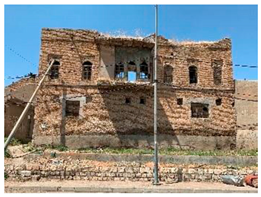 A2 | 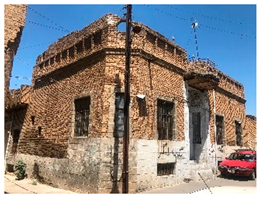 A3 |
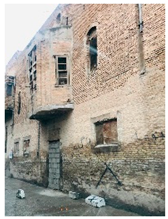 A4 |  A5 | 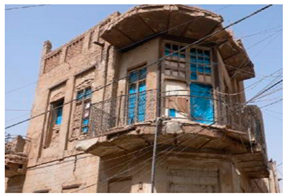 A6 |
| Case Category B | ||
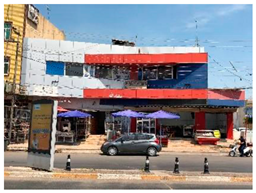 B1 | 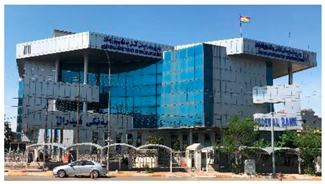 B2 |  B3 |
 B4 | 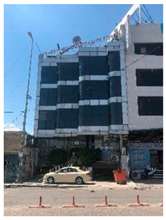 B5 | 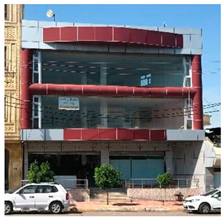 B6 |
| High-quality Heritage Buildings | |||||||
|---|---|---|---|---|---|---|---|
| Variates | Architects (n = 197) | Non-Architects (n = 217) | Mann–Whitney U | ||||
| Mean | SD | Mean | SD | ||||
| Qualitative Variables | Complex–simple | −0.43 | 1.29 | 0.29 | 0.89 | 0.00 | ** |
| Harmonious–discordant | 1.14 | 0.93 | 0.12 | 0.83 | 0.00 | ** | |
| Imaginative–unimaginative | 0.18 | 1.22 | 0.23 | 0.85 | 0.99 | - | |
| Varying–monotonous | −0.42 | 1.30 | 0.44 | 0.89 | 0.00 | ** | |
| Novel–common | 0.94 | 0.94 | 0.03 | 0.92 | 0.00 | ** | |
| Dynamic–static | −0.42 | 1.27 | 0.06 | 0.90 | 0.00 | ** | |
| Ordered–disordered | 1.04 | 0.95 | 0.24 | 0.86 | 0.00 | ** | |
| Clean–dirty | 0.15 | 1.33 | −0.24 | 0.80 | 0.00 | ** | |
| Rational–irrational | 0.73 | 0.90 | 0.21 | 0.74 | 0.00 | ** | |
| Mean | 0.33 | 0.64 | 0.15 | 0.48 | 0.01 | ** | |
| Heritage-value Variables | Identarian–non-identarian | 1.71 | 0.52 | 0.68 | 0.91 | 0.00 | ** |
| Useful–useless | 0.28 | 1.32 | 0.29 | 0.83 | 0.32 | - | |
| Authentic–fake | 1.73 | 0.48 | 0.85 | 0.86 | 0.00 | ** | |
| Symbolic–non-symbolic | 1.74 | 0.49 | 0.79 | 0.96 | 0.00 | ** | |
| Valuable–worthless | 0.79 | 1.38 | 0.84 | 0.94 | 0.25 | - | |
| Proud–shameful | 1.45 | 0.62 | 0.48 | 1.20 | 0.00 | ** | |
| Attached–detached | 1.09 | 0.75 | 0.00 | 1.00 | 0.00 | ** | |
| Mean | 1.26 | 0.53 | 0.56 | 0.74 | 0.00 | ** | |
| Affective-evaluative Variables | Impressive–unimpressive | 0.54 | 1.29 | 0.28 | 0.89 | 0.00 | ** |
| Interesting–boring | 1.03 | 1.03 | 0.23 | 0.91 | 0.00 | ** | |
| Peaceful–disruptive | 1.38 | 0.62 | −0.06 | 0.83 | 0.00 | ** | |
| Intimate–distant | 1.37 | 0.62 | 0.25 | 0.80 | 0.00 | ** | |
| Pleasant–unpleasant | 0.99 | 0.81 | 0,13 | 0.86 | 0.00 | ** | |
| Safe–unsafe | 0.26 | 1.51 | −0.33 | 0.88 | 0.00 | ** | |
| Beautiful–ugly | 1.18 | 0.78 | 0.25 | 1.00 | 0.00 | ** | |
| Comfortable–uncomfortable | 0.33 | 1.27 | −0.13 | 0.77 | 0.00 | ** | |
| Stimulating–sedate | 0.01 | 1.30 | 0.17 | 0.89 | 0.14 | - | |
| Happy–unhappy | 0.91 | 0.80 | 0.02 | 0.93 | 0.00 | ** | |
| Positive–negative | 0.91 | 0.74 | 0.20 | 0.80 | 0.00 | ** | |
| Satisfied–unsatisfied | 1.04 | 0.81 | −0.19 | 1.00 | 0.00 | ** | |
| Desirable–undesirable | 0.92 | 0.93 | 0.40 | 0.92 | 0.00 | ** | |
| Like–dislike | 1.39 | 0.70 | 0.16 | 1.03 | 0.00 | ** | |
| Mean | 0.88 | 0.39 | 0.09 | 0.53 | 0.00 | ** | |
| Contrast Buildings | |||||||
|---|---|---|---|---|---|---|---|
| Variates | Architects (n = 197) | Non-Architects (n = 217) | Mann–Whitney U | ||||
| Mean | SD | Mean | SD | ||||
| Qualitative Variables | Complex–simple | 0.38 | 1.31 | 0.12 | 0.88 | 0.02 | ** |
| Harmonious – discordant | −0.22 | 1.19 | 0.49 | 0.94 | 0.00 | ** | |
| Imaginative–unimaginative | −0.25 | 1.32 | 0.41 | 1.01 | 0.00 | ** | |
| Varying–monotonous | 0.81 | 1.23 | 0.14 | 0.75 | 0.00 | ** | |
| Novel–common | −0.65 | 1.05 | −0.10 | 0.78 | 0.00 | ** | |
| Dynamic–static | 1.22 | 0.90 | 0.42 | 0.83 | 0.00 | ** | |
| Ordered–disordered | 0.72 | 1.18 | 0.21 | 0.80 | 0.00 | ** | |
| Clean–dirty | −0.68 | 1.33 | 0.24 | 0.86 | 0.00 | ** | |
| Rational–irrational | 0.27 | 1.06 | 0.79 | 0.99 | 0.00 | ** | |
| Mean | 0.17 | 0.71 | 0.30 | 0.56 | 0.18 | - | |
| Heritage-value Variables | Identarian–non-identarian | 0.63 | 1.25 | 0.36 | 0.93 | 0.00 | ** |
| Useful–useless | −0.10 | 1.09 | 0.41 | 0.90 | 0.00 | ** | |
| Authentic–fake | −0.23 | 1.12 | 0.33 | 0.87 | 0.00 | ** | |
| Symbolic–non-symbolic | 0.38 | 1.04 | 0.95 | 0.98 | 0.00 | ** | |
| Valuable–worthless | 0.93 | 0.95 | 0.71 | 0.90 | 0.02 | ** | |
| Proud–shameful | −0.11 | 1.08 | 0.27 | 0.91 | 0.00 | ** | |
| Attached–detached | 0.13 | 1.23 | 0.93 | 0.87 | 0.00 | ** | |
| Mean | 0.23 | 0.83 | 0.57 | 0.63 | 0.00 | ** | |
| Affective-evaluative Variables | Impressive–unimpressive | −0.29 | 1.45 | 0.86 | 1.00 | 0.00 | ** |
| Interesting–boring | −0.89 | 1.10 | 0.06 | 0.75 | 0.00 | ** | |
| Peaceful–disruptive | −0.96 | 1.08 | 0.12 | 0.83 | 0.00 | ** | |
| Intimate–distant | −0.91 | 1.15 | 0.42 | 0.88 | 0.00 | ** | |
| Pleasant–unpleasant | 0.73 | 1.12 | 0.00 | 0.81 | 0.00 | ** | |
| Safe–unsafe | 1.35 | 0.92 | 0.62 | 0.79 | 0.00 | ** | |
| Beautiful–ugly | 1.07 | 1.15 | 0.20 | 0.90 | 0.00 | ** | |
| Comfortable–uncomfortable | −0.71 | 1.20 | 0.02 | 0.80 | 0.00 | ** | |
| Stimulating–sedate | 0.21 | 1.15 | 0.37 | 0.78 | 0.04 | ** | |
| Happy–unhappy | 0.42 | 0.94 | 0.44 | 0.96 | 0.45 | - | |
| Positive–negative | −0.86 | 1.24 | 0.15 | 0.93 | 0.00 | ** | |
| Satisfied–unsatisfied | 0.37 | 1.30 | 0.41 | 0.86 | 0.96 | - | |
| Desirable–undesirable | 0.62 | 1.20 | 0.49 | 0.84 | 0.05 | - | |
| Like–dislike | −0.20 | 1.10 | 0.58 | 0.93 | 0.00 | ** | |
| Mean | −0.01 | 0.69 | 0.34 | 0.51 | 0.00 | ** | |
| Category | Variate Correlations | Architects (n = 197) | Non-Architects (n = 217) | Significance Difference (p) | |
|---|---|---|---|---|---|
| High-quality buildings | Qualitative variables and affective-evaluative variables | 0.695 ** | 0.717 ** | 0.66 | - |
| Heritage-value variables and affective-evaluative variables | 0.665 ** | 0.794 ** | 0.00 | ** | |
| Heritage-value variables and qualitative variables | 0.373 ** | 0.605 ** | 0.00 | ** | |
| Contrasting Buildings | Qualitative variables and affective-evaluative variables | 0.912 ** | 0.829 ** | 0.00 | ** |
| Heritage-value variables and affective-evaluative variables | 0.918 ** | 0.632 ** | 0.00 | ** | |
| Heritage-value variables and qualitative variables | 0.839 ** | 0.562 ** | 0.00 | ** | |
Publisher’s Note: MDPI stays neutral with regard to jurisdictional claims in published maps and institutional affiliations. |
© 2021 by the authors. Licensee MDPI, Basel, Switzerland. This article is an open access article distributed under the terms and conditions of the Creative Commons Attribution (CC BY) license (http://creativecommons.org/licenses/by/4.0/).
Share and Cite
Sektani, H.H.J.; Khayat, M.; Mohammadi, M.; Roders, A.P. Erbil City Built Heritage and Wellbeing: An Assessment of Local Perceptions Using the Semantic Differential Scale. Sustainability 2021, 13, 3763. https://doi.org/10.3390/su13073763
Sektani HHJ, Khayat M, Mohammadi M, Roders AP. Erbil City Built Heritage and Wellbeing: An Assessment of Local Perceptions Using the Semantic Differential Scale. Sustainability. 2021; 13(7):3763. https://doi.org/10.3390/su13073763
Chicago/Turabian StyleSektani, Hawar Himdad J., Mahmood Khayat, Masi Mohammadi, and Ana Pereira Roders. 2021. "Erbil City Built Heritage and Wellbeing: An Assessment of Local Perceptions Using the Semantic Differential Scale" Sustainability 13, no. 7: 3763. https://doi.org/10.3390/su13073763
APA StyleSektani, H. H. J., Khayat, M., Mohammadi, M., & Roders, A. P. (2021). Erbil City Built Heritage and Wellbeing: An Assessment of Local Perceptions Using the Semantic Differential Scale. Sustainability, 13(7), 3763. https://doi.org/10.3390/su13073763





